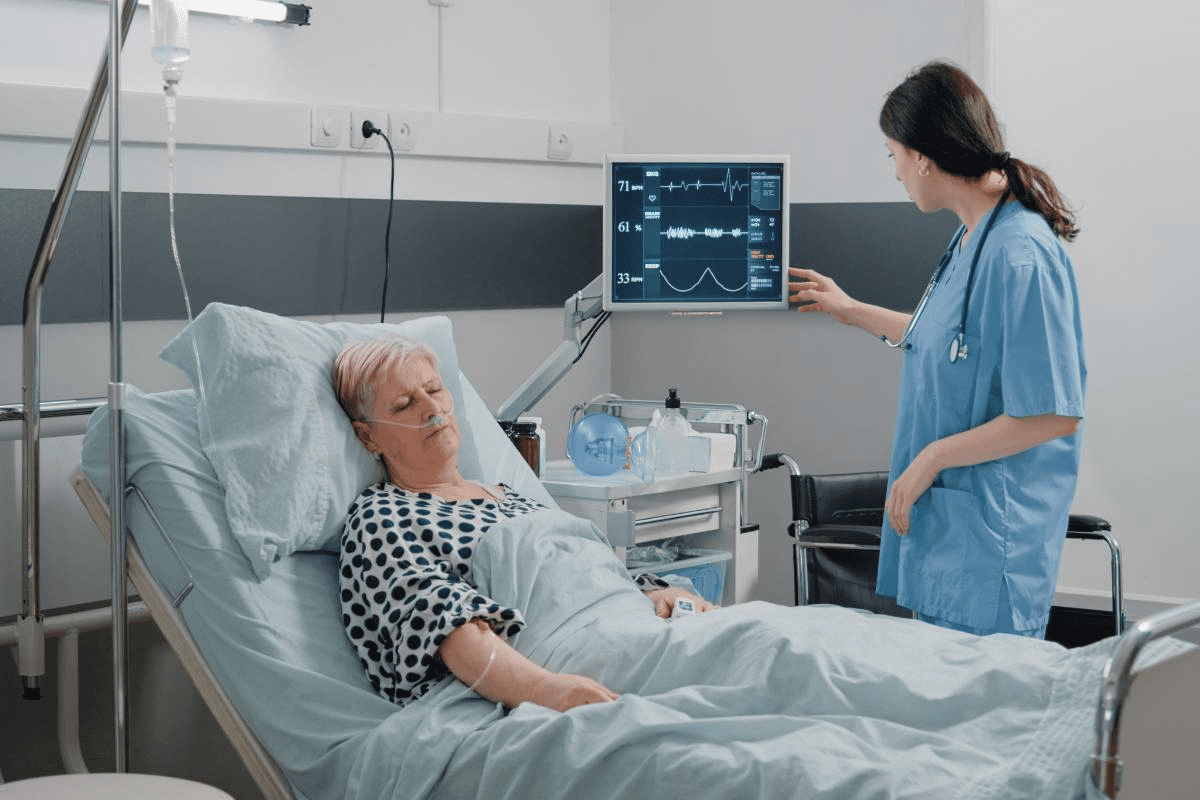Last Updated on November 27, 2025 by Bilal Hasdemir
Recent studies have made a groundbreaking discovery in the field of mental health. Using MRI brain scans, researchers have identified six distinct subtypes of depression, each characterized by unique patterns of brain activity.

This breakthrough has significant implications for the diagnosis and treatment of depression. Through brain imaging for depression, healthcare professionals can better understand specific biotypes of the disorder, allowing them to develop more effective, personalized treatment plans. This advancement brings new hope to those affected by this complex mental health condition.
Key Takeaways
- Researchers have identified six distinct subtypes of depression using MRI brain scans.
- Each subtype is characterized by unique patterns of brain activity.
- This discovery has significant implications for personalized treatment plans.
- Understanding depression biotypes can lead to more effective therapies.
- Personalized treatment can improve outcomes for individuals with depression.
The Neurological Basis of Depression
Understanding depression requires a deep dive into its neurological foundations, where changes in brain activity and structure play a crucial role. Depression is more than just a clinical condition; it’s a complex interplay of neurological factors that affects millions worldwide.
How Depression Affects Brain Structure and Function
Depression has been shown to impact various aspects of brain function, particularly in regions responsible for emotion regulation and cognitive control. Studies using advanced imaging techniques have revealed alterations in brain structure, including reduced volume in certain areas. As noted in a recent study, “Depression is associated with changes in brain connectivity, which can affect treatment outcomes.”
The impact on brain function is equally significant, with depression often leading to altered neural circuits that can disrupt normal brain activity. This disruption can result in the characteristic symptoms of depression, such as persistent sadness and loss of interest in activities.
Limitations of Traditional Diagnostic Methods
Traditional diagnostic methods for depression have relied heavily on clinical symptoms and patient self-reporting. However, these methods have significant limitations, as they do not account for the underlying neurological differences among individuals with depression. As a result, treatment outcomes can vary widely, with some patients not responding to standard therapies.
The identification of depression subtypes or “six types of depression” through advanced neuroimaging techniques represents a significant step forward. By understanding the specific neurological characteristics of an individual’s depression, healthcare providers can develop more targeted and effective treatment plans.
Brain Imaging for Depression: How MRI Technology Works
MRI technology has revolutionized the field of depression diagnosis by providing insights into brain function and structure. The use of advanced imaging techniques has enabled researchers to better understand the complex neurological underpinnings of depression.
Functional MRI (fMRI) Technology Explained.
Functional MRI (fMRI) is a non-invasive imaging technique that measures brain activity by detecting changes associated with blood flow. This method is based on the fact that cerebral blood flow and neuronal activation are coupled. When an area of the brain is in use, blood flow to that region also increases.
fMRI technology has been instrumental in studying depression by analyzing the brain’s connectivity patterns. It allows researchers to map brain activity and understand how different regions communicate with each other.
Analyzing Brain Connectivity Patterns
Brain connectivity patterns are crucial in understanding depression. fMRI scans help identify how different parts of the brain are connected and how they function together. This information is vital in diagnosing depression subtypes and understanding their neurological basis.
| Brain Region | Function | Relevance to Depression |
| Default Mode Network | Self-referential thinking | Hyperactivity associated with rumination |
| Salience Network | Emotion regulation | Abnormalities linked to mood dysregulation |
| Attention Circuit | Focus and attention | Dysfunction related to cognitive symptoms |
By analyzing these connectivity patterns, researchers can gain a deeper understanding of the neurological mechanisms underlying depression. This knowledge can lead to more effective diagnostic tools and personalized treatment plans.
The Revolutionary Discovery: Six Depression Biotypes
A pioneering study featured in National Geographic has revealed six depression biotypes, highlighting the complexity of mental health disorders. This groundbreaking research has the potential to transform the way we diagnose and treat depression.
The Research Behind the Classification
The study utilized advanced functional MRI (fMRI) technology to analyze brain connectivity patterns in individuals with depression. By examining the brain’s functional networks, researchers were able to identify distinct biotypes based on unique patterns of brain activity.
As noted by the researchers, “The identification of these biotypes could lead to more personalized and effective treatment strategies.” This approach moves beyond traditional symptom-based diagnosis, offering a more nuanced understanding of depression.
Why Different Brain Types Matter for Treatment
Understanding the different depression biotypes is crucial because it allows clinicians to tailor treatments to the specific needs of each patient. By recognizing the unique brain connectivity patterns associated with each biotype, healthcare providers can develop more targeted therapeutic approaches.
- Improved treatment efficacy
- Enhanced patient outcomes
- More precise diagnostic tools
Objective Biomarkers vs. Symptom-Based Diagnosis
Traditional diagnostic methods often rely on symptom-based assessments, which can be subjective and variable. The new classification system, on the other hand, utilizes objective biomarkers derived from brain imaging data. This shift towards a more data-driven approach could significantly improve diagnostic accuracy and treatment outcomes.
“The use of objective biomarkers represents a major advancement in psychiatric research, enabling clinicians to move beyond symptom-based diagnosis and develop more effective treatment plans.”
By embracing this innovative approach, the field of psychiatry is poised to make significant strides in understanding and treating depression.
Type 1: Default Mode Network Depression
Default Mode Network Depression, a newly identified subtype, is characterized by distinct brain connectivity patterns. This subtype has been identified through advanced MRI brain scans, which have revealed unique insights into the neurological basis of depression.
Brain Connectivity Characteristics
The Default Mode Network (DMN) is a set of brain regions that are typically active when a person is not focused on the external world. In individuals with Default Mode Network Depression, there are altered connectivity patterns within the DMN. Research has shown that these alterations can lead to increased self-referential thinking and rumination, which are common features of depression.
A study published in a leading neuroscience journal found that individuals with Default Mode Network Depression exhibited increased connectivity between the medial prefrontal cortex and other regions of the DMN. This heightened connectivity is thought to contribute to the characteristic symptoms of this subtype.
“The identification of Default Mode Network Depression as a distinct subtype has significant implications for treatment. By understanding the specific brain connectivity patterns associated with this subtype, clinicians can develop more targeted interventions.”
Common Symptoms and Clinical Presentation
Individuals with Default Mode Network Depression often present with symptoms that are typical of depression, including persistent sadness, loss of interest in activities, and changes in appetite or sleep. However, they also exhibit unique clinical features, such as increased rumination and self-focused thinking.
| Symptom | Frequency | Severity |
| Persistent Sadness | High | Severe |
| Loss of Interest | Moderate | Moderate |
| Rumination | High | Severe |
Typical Treatment Responses
Treatment for Default Mode Network Depression typically involves a combination of pharmacological interventions and psychotherapy. Research has shown that individuals with this subtype may respond well to treatments that target the DMN, such as cognitive-behavioral therapy (CBT) and mindfulness-based interventions.
By understanding the unique characteristics of Default Mode Network Depression, clinicians can develop more effective treatment plans tailored to the specific needs of individuals with this subtype.
Type 2: Salience Network Depression
Advances in neuroimaging have enabled researchers to identify Salience Network Depression as a unique depression biotype with specific brain connectivity features. This subtype of depression is characterized by distinct patterns in the salience network, a brain system crucial for detecting and filtering salient stimuli.
Brain Connectivity Characteristics
The salience network, which includes regions such as the anterior cingulate cortex and insula, plays a vital role in switching between different brain networks. In Salience Network Depression, altered connectivity within this network can lead to difficulties in appropriately responding to emotional stimuli.
This altered connectivity can result in an overemphasis on negative stimuli, contributing to depressive symptoms. Studies have shown that individuals with this subtype exhibit different patterns of brain activity when processing emotional information.
Common Symptoms and Clinical Presentation
Individuals with Salience Network Depression often present with symptoms that include heightened emotional sensitivity and reactivity. They may experience intense feelings of anxiety or irritability in response to stimuli that would not typically provoke such reactions in others.
- Increased emotional reactivity
- Heightened sensitivity to stress
- Difficulty in regulating emotional responses
Clinically, these individuals may be diagnosed with depression, but the underlying brain connectivity issues suggest a need for targeted therapeutic approaches.
Typical Treatment Responses
Treatment for Salience Network Depression may involve therapies that focus on improving emotional regulation and reducing sensitivity to negative stimuli. Cognitive-behavioral therapy (CBT) and mindfulness-based interventions have shown promise in helping individuals manage their symptoms.
In some cases, medications that target emotional regulation may also be effective. The key is to tailor the treatment to the individual’s specific brain connectivity characteristics and clinical presentation.
Type 3: Attention Circuit Depression
The attention circuit plays a crucial role in a newly classified depression subtype known as Attention Circuit Depression. This condition is characterized by distinct brain connectivity patterns that affect an individual’s attention and cognitive processing.
Brain Connectivity Characteristics
Attention Circuit Depression is associated with altered connectivity within the brain’s attention networks. Research has shown that individuals with this subtype exhibit different patterns of neural communication compared to other depression types. Specifically, there’s often a disruption in the salience network, which is crucial for detecting relevant stimuli.

Common Symptoms and Clinical Presentation
Individuals with Attention Circuit Depression may experience a range of symptoms, including difficulties with concentration, memory issues, and challenges in maintaining focus on tasks. According to recent studies, these symptoms can significantly impact daily functioning and quality of life.
| Symptom | Frequency | Impact on Daily Life |
| Difficulty Concentrating | High | Impact work and study |
| Memory Issues | Moderate | Affects daily tasks |
| Maintaining Focus | High | Reduces productivity |
Typical Treatment Responses
Treatment for Attention Circuit Depression often involves a combination of pharmacological interventions and cognitive-behavioral therapy (CBT). Tailoring treatment to the specific brain connectivity characteristics of this subtype can lead to more effective outcomes. For instance, therapies that enhance cognitive control and attention may be particularly beneficial.
Understanding the nuances of Attention Circuit Depression is crucial for developing personalized treatment plans. By recognizing the distinct brain connectivity patterns and clinical presentations associated with this subtype, healthcare providers can offer more targeted and effective care.
Types 4-6: Additional Depression Biotypes
Recent studies have identified additional depression biotypes, shedding light on the complexity of the disorder. These new classifications have significant implications for diagnosis and treatment.
Mood Regulation Network Depression (Type 4)
Mood Regulation Network Depression is characterized by disruptions in the brain’s mood regulation circuitry. Patients with this biotype often experience intense emotional dysregulation, which can manifest as extreme mood swings. Treatment for this type typically involves a combination of pharmacological interventions and psychotherapy aimed at stabilizing mood.
Cognitive Control Depression (Type 5)
Cognitive Control Depression involves abnormalities in the cognitive control network of the brain. Individuals with this biotype may struggle with concentration and decision-making. Targeted cognitive training and cognitive-behavioral therapy are often recommended as part of the treatment plan.
Mixed Network Depression (Type 6)
Mixed Network Depression is a complex biotype that involves multiple brain networks. It is associated with a mix of symptoms, including mood dysregulation, cognitive impairment, and anxiety. Treatment for Mixed Network Depression usually requires a multi-faceted approach, incorporating various therapeutic modalities.
Comparative Treatment Efficacy
A comparative analysis of treatment efficacy across these biotypes reveals that personalized treatment plans yield better outcomes. For instance, patients with Mood Regulation Network Depression respond well to mood stabilizers, while those with Cognitive Control Depression benefit from cognitive training. As noted by a recent study, “The identification of distinct depression biotypes allows for more targeted and effective treatment strategies.”
“The identification of distinct depression biotypes allows for more targeted and effective treatment strategies, ultimately improving patient outcomes.”
Understanding these additional depression biotypes is crucial for developing effective treatment protocols. By recognizing the unique characteristics of each biotype, clinicians can tailor their approaches to meet the specific needs of their patients.
Implications for Treatment-Resistant Depression
The discovery of depression biotypes has opened new avenues for understanding treatment-resistant depression. For years, clinicians have struggled to treat patients who do not respond to standard depression treatments. The identification of specific brain connectivity patterns associated with different depression biotypes offers a promising solution to this challenge.
Understanding Why Some Patients Don’t Respond to Treatment
One of the primary reasons some patients don’t respond to treatment is that their depression is driven by different underlying neurological mechanisms. For instance, Default Mode Network Depression is characterized by hyperconnectivity within the default mode network, which may not be adequately addressed by standard treatments. Understanding these differences is crucial for developing more effective treatment strategies.
The various depression biotypes identified through MRI scans include:
- Type 1: Default Mode Network Depression
- Type 2: Salience Network Depression
- Type 3: Attention Circuit Depression
- Type 4: Mood Regulation Network Depression
- Type 5: Cognitive Control Depression
- Type 6: Mixed Network Depression
Personalized Medicine Approaches Based on Brain Type
Personalized medicine approaches tailored to an individual’s specific depression biotype represent a significant advancement in depression treatment. By identifying the unique brain connectivity patterns of a patient, clinicians can develop targeted treatment plans that are more likely to be effective.
Liv Hospital is at the forefront of this innovative approach, utilizing advanced MRI technology to classify depression biotypes and develop personalized treatment protocols. This approach not only improves treatment outcomes but also reduces the trial-and-error process that often accompanies depression treatment.

Innovative Treatment Protocols at Liv Hospital
Liv Hospital’s commitment to innovative treatment protocols is exemplified by its use of advanced brain imaging techniques to guide treatment decisions. By understanding the specific brain type of a patient, clinicians can select from a range of treatment options, including:
- Targeted pharmacological interventions
- Personalized psychotherapy approaches
- Neurostimulation therapies tailored to the individual’s brain connectivity patterns
This personalized approach to depression treatment has the potential to revolutionize mental health care by providing more effective and targeted treatments for patients with treatment-resistant depression.
Conclusion: The Future of Personalized Depression Treatment
The identification of depression biotypes through brain imaging has revolutionized our understanding of this complex condition. By recognizing the distinct neurological characteristics of different depression types, clinicians can now tailor treatment approaches to individual patients, paving the way for more effective personalized depression treatment.
This breakthrough in brain imaging technology has significant implications for the future of depression treatment. As research continues to uncover the intricacies of depression biotypes, we can expect to see the development of more targeted and effective treatment protocols.
The integration of brain imaging into clinical practice has the potential to transform the field of psychiatry, enabling healthcare providers to move beyond symptom-based diagnosis and towards a more nuanced understanding of the underlying neurological mechanisms driving depression.
As we look to the future, it is clear that personalized depression treatment will play an increasingly important role in improving patient outcomes. By leveraging advances in brain imaging and depression research, we can work towards a more compassionate and effective approach to treating this debilitating condition.
FAQ
What are depression biotypes, and how are they identified?
Depression biotypes are distinct subtypes of depression identified through MRI brain scans, specifically using functional MRI (fMRI) to analyze brain connectivity patterns.
How does fMRI technology work in understanding depression?
fMRI technology analyzes brain connectivity patterns by measuring changes in blood flow and activity in different brain regions, helping to identify distinct depression subtypes.
What are the six depression biotypes revealed by MRI brain scans?
The six depression biotypes are: Default Mode Network Depression, Salience Network Depression, Attention Circuit Depression, Mood Regulation Network Depression, Cognitive Control Depression, and Mixed Network Depression.
How do depression biotypes impact treatment approaches?
Understanding depression biotypes allows for personalized treatment approaches, as different biotypes may respond differently to various treatments, improving treatment efficacy.
Can brain scans diagnose depression?
While brain scans, such as fMRI, cannot directly diagnose depression, they can help identify depression biotypes and provide valuable information for treatment planning.
What is the significance of objective biomarkers in depression diagnosis?
Objective biomarkers, such as brain connectivity patterns, can improve depression diagnosis by providing a more accurate and reliable method beyond traditional symptom-based diagnosis.
How do depression biotypes relate to treatment-resistant depression?
Understanding depression biotypes can help identify why some patients don’t respond to treatment, allowing for personalized medicine approaches and innovative treatment protocols.
What is the role of brain imaging in personalized depression treatment?
Brain imaging, particularly fMRI, plays a crucial role in identifying depression biotypes, enabling personalized treatment approaches, and improving treatment outcomes.
Are there different treatment responses for different depression biotypes?
Yes, different depression biotypes may respond differently to various treatments, highlighting the importance of personalized treatment approaches.
How can understanding depression biotypes improve treatment outcomes?
By identifying distinct depression biotypes, clinicians can develop targeted treatment plans, improving treatment efficacy and overall patient outcomes.
References:
- Drysdale, A. T., et al. (2017). Resting-state connectivity biomarkers define neurophysiological subtypes of depression. Nature Medicine, 23(1), 28“38. https://www.nature.com/articles/nm.4246
- Leuchter, A. F., et al. (2015). Neuromarkers for major depressive disorder: Replicable evidence for three subtypes. Neuropsychopharmacology, 40(8), 1847“1855. https://www.nature.com/articles/npp201513






